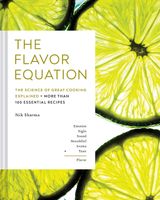Advertisement
A Basic Primer on Flavor Science
Appears in
By Nik Sharma
Published 2020
At its very essence, cooking is a thoughtful scientific approach—discovery through trial and error—married to our emotions and improved through repetition. I’ve always viewed cooking as an experiment that is driven by the hopeful outcome of pleasure and nourishment.
Be it the water in your drinking glass, the butter you slather on your morning toast, the lime juice you squeeze over your salad, or the saffron you grind to add fragrance and color to your rice, every ingredient we use is made up, at the microscopic level, of molecules that influence the way we approach our food—the way we think, see, choose, cook, smell, and taste. A splash of malt vinegar over a bag of hot, freshly fried fish and chips adds sourness because of the acid molecules it carries; a sweet potato that’s roasted tastes sweeter than it did when uncooked because the starch is converted to sweet-tasting sugar molecules; the jolt of heat that you feel when you bite into a fresh serrano chilli comes from a molecule that triggers your nerves; even that creamy velvety texture of yogurt is the result of a complex mixture of fat, proteins, sugars, acids, and water (among other molecules) that give yogurt its flavor and shape.

